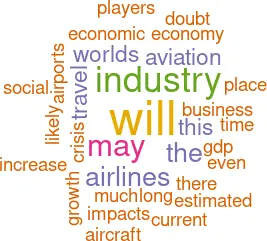Future Size
and Shape
Mar/Apr 2020


What will the aviation industry look like when it finally emerges from the existential crisis of the Coronavirus pandemic? At the moment that is an unanswerable question, and depends so much on how long the world’s economy remains stalled, the world’s population stays in lock-down and borders stay closed. There is a distinct possibility that it will change beyond recognition: we can only speculate.
Politically, aviation is of strategic national importance. Commercial airlines themselves account for 1% of GDP, but there are huge swathes of the economy that depend on aviation: travel, tourism, hospitality, let alone trade and global business contacts and suppliers. The total economic effect including direct, indirect and induced impacts, has been estimated at around 3.5%-4% of global GDP. This rises to and estimated 8%-10% of GDP when taking catalytic impacts into account.
Airlines directly employ an estimated 2.7m people world-wide, out of 10.2m employed in the aviation industry as a whole (including airports, airport-based roles, manufacturers, air traffic controllers). But it supports induced and indirect employment of around 18.5m in related businesses and over 40m jobs in tourism.
It is essential for trade, and it will be vital for many countries to ensure continuation of air connections to enable their economies to emerge from the looming worldwide recession.
The longer the crisis lasts, the more individual airlines will run out of cash and face failure. The world’s top airlines will no doubt be supported — some may be viewed as “too big to fail”. But there are a large number of small and medium sized carriers whose continued existence even in the best of times has been on a wing and a prayer.
This could be an opportunity for some nation states to forego the perceived need to have a national flag carrier, and cheaper for them to invite stronger players into their markets to “guarantee” connectivity.
A subsequent development could be to move towards the ICAO preferred model that removes the substantial ownership requirement from bilaterals.
Perhaps equally likely is an increase in protectionism under pressure from populist nationalist politics and anti-globalisation movements. In any case, the industry is likely to consolidate through attrition. This in turn could lead to regulatory changes. Apart from anything else, the current cash crisis highlights how much the industry depends on advance payments for working capital, and consumer backlash may suggest to regulators that such funds be restricted. There is a possibility that health screening at airports become mandatory.
The drivers behind traffic growth may well change. Businesses, stung by the economic impacts of the closing of the world’s economy will no doubt severely restrain travel budgets for some time even through a recovery. Having discovered that business meetings can easily take place through digital forums, it may be that these budgets will never be fully restored.
However, in each of the past industry cycles similar arguments have been proposed for technological advances to obviate the need for physical meetings, and for the very simple reason that humanity is a social animal and trust relies on the physical ability to see the “white of the eyes”, business travel will no doubt resume, but perhaps at a lower elasticity to economic growth.
Leisure travel will surely resume. It may take a long time for China, which had provided so much of the engine of growth to the industry in the last decade, to return to its position as the largest outbound tourist market, but the social dynamics that would lead it there are probably still in place.
Fear and distrust, and the practise of social distancing might even put pressure on airlines to increase personal space on board unwinding decades of seat “densification” (although it is a bit difficult to imagine how airports could do the same). This, a smaller industry, and the significant increase in a debt burden on surviving players could well add to costs and fares to put a dampener on leisure demand recovery.
There is a faint hope that new players will eventually emerge — there is likely to be a very large number of aircraft with reasonable remaining useful lives that could return from storage, while the manufacturers as in the aftermath of September 11 could become desperate to place new aircraft.
The first phase of the long-haul low cost model may not survive in its current form and with current proponents, but the availability of cheap long haul aircraft might suggest to the likes of Ryanair that the time is ripe to develop for the opportunity.